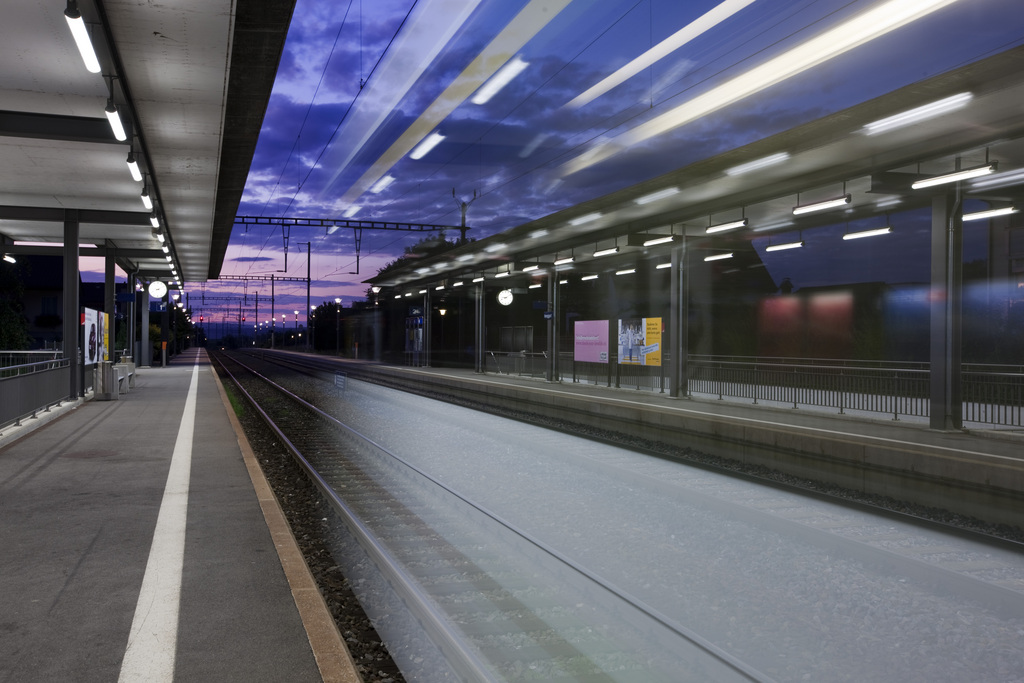Swiss railways could benefit from fresh cash boost

Voters have been asked to give the seal of approval to a wide-ranging package that would put future Swiss railway infrastructure investments on a solid financial footing. But opponents say the plan is on the wrong track.
Less congestion on the streets, more seats on trains, half-hourly connections on main routes, expansion in all regions, better regulation of freight traffic – all this and much more is promised by a new bill. Every canton is to get a slice of the action, worth CHF6.4 billion ($7.2 billion).
“This is not a transport policy – it’s a wish list,” said rightwing Swiss People’s Party senator Ulrich Giezendanner, who also owns a trucking firm. “Every person added something in for their region. And this was sanctioned in parliament because people were fearful their region would end up with nothing.”
Evi Allemann, a centre-left Social Democratic Party member of the House and president of the Transport and Environment Association, disagreed.
“We have a railway network that has been built on the idea that all regions are well-connected,” she said. “The proposal’s greatest strength is precisely because it is balanced. It offers something to all regions and to a great many people all over the country.”
“Historic vote”
The cabinet has characterised the upcoming vote on the fund as “historic”. It is a counter-proposal to an initiative that was successfully spearheaded by the Transport and Environment Association and other organisations and would have modified the constitution.
Those backing the initiative were sufficiently satisfied with the government counter-proposal to withdraw their initiative last summer. It has also convinced the cantons and the country’s two largest automobile associations – the Automobile Club of Switzerland and the Touring Club Switzerland.
Two central points of the plan are the creation of a new fund and a strategic infrastructure programme. The open-ended fund is expected to finance the use, maintenance and expansion of the existing network.
In contrast, its predecessor was limited to a set period to finance large projects such as the new Gotthard and Lötschberg tunnels.
The financing for railway infrastructure would come from federal funding, the heavy goods vehicle tax, a share of the mineral oil tax and value-added tax. New resources of around CHF1 billion are also anticipated through lowering deductions for travel costs on federal income taxes and from cantonal contributions.
In addition, value-added tax would be increased by 0.1% from 2018 to 2030. Ultimately, passengers should be able to demand lower ticket prices.
After the regulation of the railway network, parliament is planning to introduce a similar open-ended fund to put national highways and metropolitan transport traffic on a firm financial footing.
The current infrastructure fund for financing road projects would also be expanded.
Parliamentary debates will begin in 2014. The new financing structure would come into effect in 2017 at the earliest.
Parallel to this an all-party committee has launched the so-called “milk cow” initiative. This would mandate that all taxes contributed by road users be fully earmarked for roads. Today much of that money is siphoned off for other uses.
According to the initiators, the required signatures will be handed over to the federal chancellery at the beginning of 2014.
Too much, too fast?
The strategic infrastructure programme is the second main point of the proposal. It anticipates a step-by-step long-term expansion of the Swiss railway network, with the first stage expected to cost approximately CHF6.4 billion.
“On the one hand, the project guarantees the ongoing financing of public transport, on the other it sets forth very concrete expansion stages that, for instance, will offer commuters more space on trains and on platforms,” said Allemann.
But it is precisely this expansion that is the main bone of contention. Whereas the government suggested spending CHF3.5 billion on the initial stage, parliament increased this to CHF6.4 billion.
“Consumers will foot the bill for what the politicians want,” criticised Giezendanner, who says he is not against regulating the financing of transport. “However, you have to know where the money is going to come from. In Switzerland, that is no longer clear.”
Further discord
Giezendanner, who according to his own estimate loads about 13,000 trains with goods per year, is not opposed to public transport. Rather, he feels that the proposal does not meet actual needs. “Freight transport, a share of which must be transferred to rail under the constitution, has been practically ignored,” he said.
Allemann disputes this. “Freight trains run on the same network as passenger trains. If this network is well maintained, both benefit,” she reckoned.
Another criticism by Giezendanner is that roads generally get a raw deal. “You have to realise that 15% of traffic in Switzerland goes by rail and 85% uses the roads. But we’re only investing in rail. That means there won’t be enough money for road traffic,” he added.
Allemann thinks the project will also be advantageous for road users. “By transferring traffic from the streets to the rails we make roads less crowded for those who really depend on them,” she said. “And in terms of climate and energy policy, it only makes sense to expand the railway system.”
Another point of dispute is deductions from federal income taxes for commuters, which would limit to CHF3,000 per year according to the proposal. “If you take away the deduction for car users, then that’s a tax increase for individual households, a hidden tax,” criticised Giezendanner.
Allemann points out though that many people in Switzerland do not pay any federal taxes at all. “The deduction only affects those who earn a lot of money and therefore pay federal taxes – and commute a lot,” she said.
Because the federal constitution has to be adapted if the proposal is accepted at the ballot box, a majority of voters as well as a majority of cantons must vote in favour.
Swiss voters will have the final say at the ballot box on February 9.
(Translated from German by Kathleen Peters)

In compliance with the JTI standards
More: SWI swissinfo.ch certified by the Journalism Trust Initiative









You can find an overview of ongoing debates with our journalists here . Please join us!
If you want to start a conversation about a topic raised in this article or want to report factual errors, email us at english@swissinfo.ch.